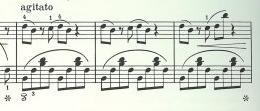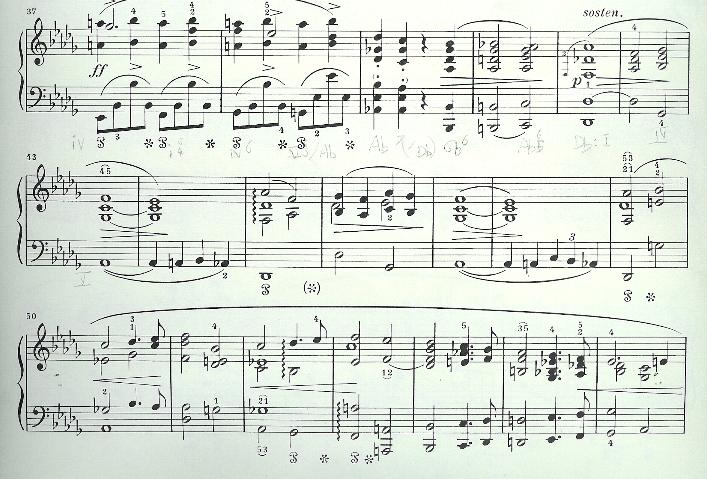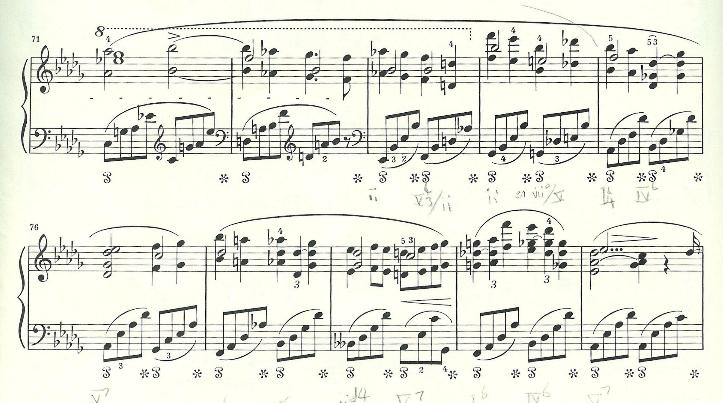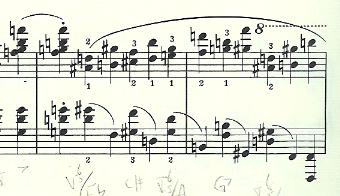4 May 2006
Chopin, Piano Sonata No. 2, Op. 35, in B-flat minor, 1st Movement, Exposition
I'm approaching Chopin's second piano sonata in order; I'm not jumping around, but I keep aware of what's coming up and where each section fits in the whole. The first movement is in the classical minor-key sonata form with a rhythmic first theme in B-flat minor and a more melodic second in its relative major, D-flat. The exposition closes with two codas. The development contains a conversation between the two themes--beginning with the first theme in the bass punctuated by first shorter then more extended passages quoting the second theme in the soprano. More technical variations on the first theme slowly take over the bulk of the development, resolving with a recapitulation marked by the return of the second theme in B-flat major. The second theme contains few variations, and the movement ends with the two codas plus a third, more chromatic coda that contains a quote of the first theme and ends in B-flat major.
Looking at the exposition section, the first theme is presented with a written repeat, measures 9 through 20 and 25 through 36, and is marked throughout by a prominent yet short rhythmic pattern that is a key component of the bulk of the development.

The theme trades sparse harmonies--primarily i and vii7--for a constant bombardment of eighth notes. The transition between the repeats acts notably as a chaotic, chromatic break with the theme proper. Because it contains the exact same eighth note rhythms in each hand as the rest of the theme, the diminished chord harmonies and non-chordal half steps builds a minor tension before the return.

A quick bridge gets us to D-flat major and the second theme. This immediately trades the eighth notes of the first theme for half and quarter notes that help accentuate the melody as it takes longer and longer breaths. Whereas the key characteristic of the first theme is expressed in a terse six eighth notes, the second theme begins as economically with only five, but continues with a long slur that sings across eight measures (the theme begins on the last two measures of the first staff system below).

Like the first theme, the second has a written repeat, measures 41 through 56 and 57 through 80, but with greater variation and much greater harmonic and melodic development transitioning into the first coda. The end section of the second theme (measures 73 through 80) is one aspect of this piece that affected me with its earnest romanticism and liberal declaration across several octaves. Here it is (beginning on the third measure):

The harmonic analysis of this closing section holds more information than that of the equally varied first theme transition quoted above. Whereas the transition is better described by a series of half-step alterations, this section of the second theme gives up a great deal of itself from its chords. Viewed in two measure phrases, it procedes from two measures tonicizing the ii then the V, then three pairs with different harmonizations of I-IV-V underneath increasingly complex variations of the same melodic fragment ending in a perfect cadence in D-flat (not shown).
The exposition ends with two codas. The first consists of 12 measures: 4 measures repeating a very simple I V/V V I up and down two octaves, 4 varying that as I vii/V V I, then an abrupt shift to a similar phrase but in C major. C will be revisited early in the development. I really dislike these over-obvious harmonies--especially with the earlier, nuanced sections. I understand the need for a simple declaration of key here at the end, and it's simplicity lends greater force to the introduction of C major (via a German 6th), but I still have a problem with it.
The two measures before the second coda puzzled me for the first couple of readings (beginning on the second quarter note of the measure, played as triplets):

It actually sits in your hands more comfortably than it looks. Put simply: the soprano jumps tritones of the vii7 of C minor, the alto walks an octatonic scale of the same chord, and the left hand plays broken major 6ths (dim 7ths) of the same chord in contrary motion. Everything describes the vii7, but the octatonic scale introduces some chromatic noise for the inner voice. A distinct variation on the pattern is in the left hand on the fourth quarter note of measure 91: the left hand steps a tritone instead of a major 6th. This is important. I've been speaking of these two measures as two patterns--one in the right hand and one in the left--that effect a leading tone diminished 7th chord. This is all true, and the intended speed will blur much of the distinctions away, but the voicing ultimately suggests a progrssion of V65/Eb C# V65/A V42/C V65/Eb. The C# is an enharmonic equivalent to the key of the second theme and would otherwise be V42/F# if the pattern were maintained. The choice is, simply, a reinforcement of the key of D-flat.
The second coda begins in C major and quickly works back, through a series of half-step progressions, to D-flat major and a somewhat ambivalent cadence tonicizing the dominant. Within the context of the exposition repeat, this acts as a jarring deceptive cadence to the vi (B-flat minor) and the minor tonic of the first theme. For the development, this acts as--and I could be wrong, so don't quote me--the V/V of F-sharp minor. More later.
I have the exposition in my hands now and need to work on consistency, expressiveness, and velocity as I continue with the rest of the movement. I'll try to spend 80% of my time on new music and 20% on refining what I have.
- Where was I? - 15 April 2006, begin practicing
- Chopin list - 26 May 2005, order received!
- Sheet music purchase - 11 May 2005, ordered sonata from Sheet Music Plus
- Piano fingering for diminished scales - 7 March 2005
- The vinyl and the concert posted by sstrader on 21 May 2016 at 1:59:26 PM
- Rod McKuen posted by sstrader on 22 March 2016 at 8:58:35 PM
- More political transcriptions posted by sstrader on 20 March 2016 at 10:19:06 AM
- Notes on We Don't Care About Music Anyway posted by sstrader on 7 June 2015 at 1:06:34 PM
- Ives Concord Sonata posted by sstrader on 13 February 2015 at 5:13:17 PM